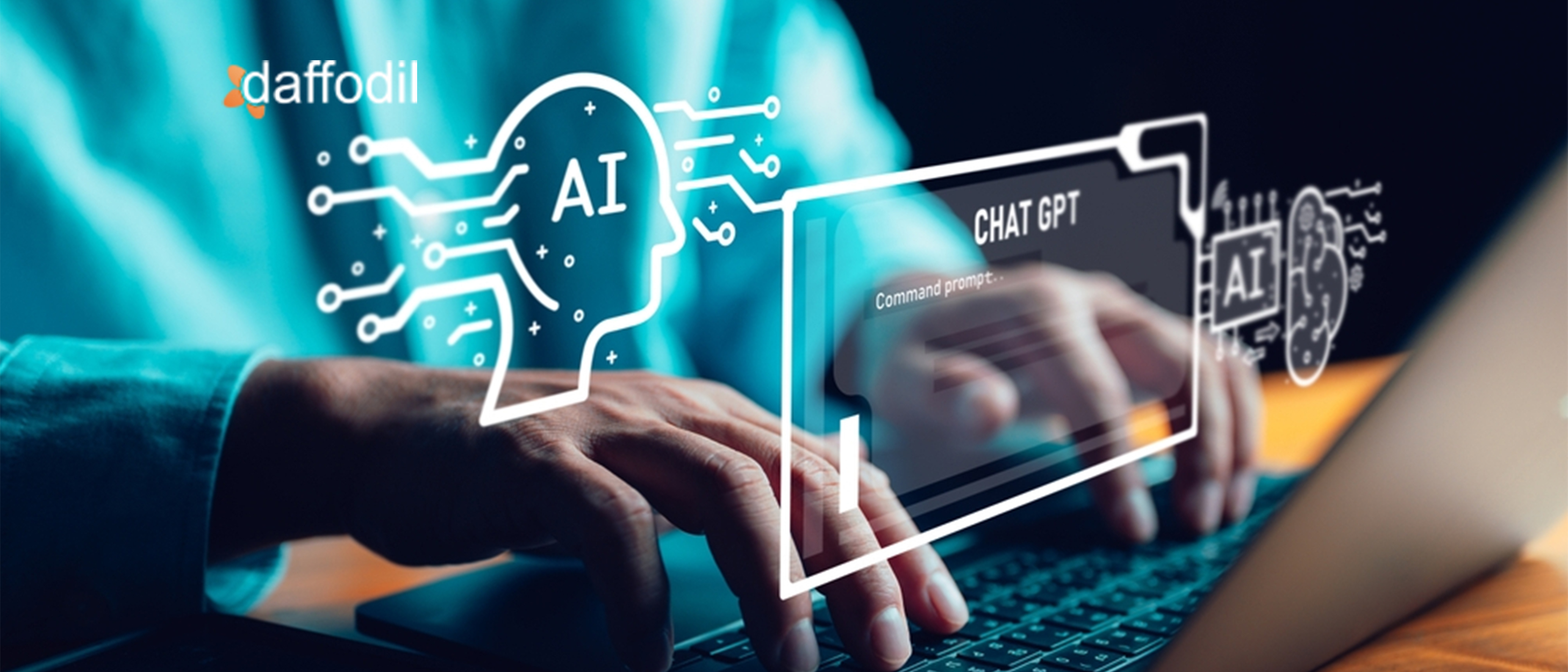
With the advent of Artificial Intelligence (AI), businesses have dramatically changed their operations and processes. As AI applications and tools have developed, businesses have been able to make more informed decisions and automate repetitive tasks, resulting in more efficient and effective operations. One of the most advanced AI algorithms that have gained prominence across various industries is Generative AI.
According to Gartner’s “Emerging Technologies and Trends Impact Radar for 2022" report, generative AI is considered to be one of the most impactful and rapidly evolving technologies on the market.
Top tech giants, like Microsoft, Google, Meta, and others, have been actively investing in these advanced generative AI algorithms like Generative Adversarial Networks (GANs), Large Language Models (LLMs), and Generative Pre-trained Transformers (GPT). Generative AI allows businesses to quickly generate solutions that enable them to create new products and services and stay competitive in an ever-changing market.
For example, ChatGPT is a popular generative AI tool that has created a buzz in the whole world with its robust capabilities.
In this article, we’ll delve into the details of generative AI and ChatGPT examples across multiple industries.
What is Generative AI?
Generative AI is a subfield of Artificial Intelligence that leverages Machine Learning techniques like unsupervised learning and semi-supervised learning algorithms to create new plausible content using existing forms of media, such as text, images, audio, and video files. Today, businesses are even using tools like an AI video generator to create high-quality, personalized video content at scale with minimal manual input.
In this algorithm, the language model is trained to identify the underlying patterns and structures related to the input and generate new content that is based on the training data without any human intervention.
It can be utilized in various ways, such as creating art, producing music and video, or even generating code for developing applications. By analyzing data using advanced algorithms, generative AI tools help businesses identify novel insights and streamline operations.
By 2025, generative AI will account for 10% of all data produced, up from less than 1% today.
How does Generative AI Work?
As Generative AI evolves, it can take new forms. But at its core, it uses tools like neural networks – in the form of GANs, transformers, and variational auto-encoders to take input data and generate new creations.
Generative AI varies from discriminatory AI algorithm, which attempts to classify incoming data inputs based on what they have been trained on. In contrast, it relies on modeling that formulates its own judgments based on the training data and generates synthetic information.
There are three main techniques which include:
1. Generative Adversarial Networks (GANs): It is used to generate visual and multimedia content from images and texts. It includes two neural networks namely a generator and a discriminator. The generator network produces new content similar to the original training data whereas the discriminator network evaluates the quality of output produced by the generator to the actual training dataset. During this adversarial training, both algorithms help train the other, the generator learns which results are more accurate while the discriminator learns which results are most likely to reflect realism.
2. Transformers: Transformer is a single network that has been trained over the years to generate the most realistic solutions. Transformer models such as GPT-3, laMDA, and Wu-Dao, utilize massive datasets to emulate cognitive attention and measure the importance of each part of the data input. For example, ChatGPT is said to have more than 175 billion parameters to generate new content.
3. Variational Auto-encoders: It is a deep learning technique that relies on compression algorithms. In this algorithm, the encoder first compresses the input data using some previously identified patterns and structures and then tries to reconstruct the output by minimizing the reconstruction error. If implemented correctly, this compressed representation can gather the input data distribution in a much smaller dimensional to get a more accurate view of the representational latent vectors. It can have a variety of applications such as dimensionality reduction, image compression, anomaly detection, and feature extraction.
This technology has multiple applications, including generating new write-ups, creating life-like images, refining low-quality images, generating code without manual coding, extracting new images from text descriptions, and so on.
As per the recent news, Microsoft has already invested $1 billion into ChatGPT and plans to invest $10 billion more to integrate this Generative AI algorithm into its search engine Bing and Office suite. According to Microsoft, this AI chatbot will be leveraged to summarize call meetings, including automating notes, personalized highlights, and suggesting tasks based on conversations had during the meeting.
So now let’s discuss why people are gushing over this AI chatbot and how ChatGPT integration can disrupt various industries.
Top 4 ChatGPT Implementations Across Various Industries
There are diverse industries that can benefit from the use of ChatGPT which include —
Healthcare
One of the fastest-growing sectors in the world is the healthcare industry, which is constantly evolving to meet patients' changing needs. As technology advances, AI-powered chatbots have become a pivotal tool for healthcare providers, offering an array of benefits to both patients and physicians. With Chatgpt’s extensive capabilities, it is considered as state-of-the-art in conversational AI that has several use cases in the healthcare industry.
1. Smart Assistant: ChatGPT can be a virtual assistant to get immediate access to information about patients’ health conditions. It can respond to patients’ questions about symptoms, medical procedures, and prescription drugs with accurate and timely information.
2. Customer Support: Using ChatGPT, healthcare providers can improve customer experience by reducing response times. It can quickly provide information to common questions about insurance, billing, and appointments.
3. Clinical Decision-making: Using NLP, this generative AI tool can assess large sets of unstructured data like Electronic Health Records (EHRs) to identify valuable information and help physicians with patient diagnosis and critical decision-making.
4. Personalized plans: By using this AI chatbot, personalized treatment plans can also be created based on a patient's medical history, genetics, and lifestyle in order to reduce adverse reactions and increase treatment effectiveness.
5. Drug discovery: Researchers and pharmaceutical businesses can leverage ChatGPT to analyze large data sets on drug interactions, side effects, and efficacy, which helps in drug discovery and repurposing.
As per Gartner's prediction, Generative AI will be used by 50 percent of drug discovery and development initiatives by 2025.
Also read: Top 7 Applications of AI in Healthcare
Real Estate
The real estate industry is booming with customers all over the world. Therefore, it’s crucial that you offer them your best services. However, hundreds, if not thousands, of these potential leads visit your website and sift through your offerings every week. They come to get solutions for their queries and instead they are bombarded with information about how you’re the best in your industry and how many customers you have.
When it comes to real estate, the average cost of missing a customer is a lot more than losing a customer in e-commerce, so every lead you lose is a significant loss in revenue.
However, with a real estate AI chatbot, organizations can engage with customers, answer their queries, schedule site visits, share and collect documents, verify documents, and also remind them of EMIs or upcoming schedules. This ultimately improves customer experience, which in turn leads to customer loyalty and more customers.
Using Generative AI services, you can predict the value of a property based on factors such as location, size, and access to amenities. It can help real estate agents and investors determine the value of a property quickly and accurately.
Moreover, ChatGPT can generate personalized property recommendations based on a buyer’s search history and preferences. As a result, buyers may have an easier time finding properties that suit their specific needs.
Finance
As technology has evolved, customers have been able to transfer funds, exchange details, authenticate and conduct transactions with just a few clicks. And, nowadays, the only reason you'd go to your bank physically is to speak with a bank teller. With AI chatbots on the rise, financial institutions are even gaining that conversational AI advantage.
By using ChatGPT, you can be 24/7 available for your customers regardless of time or location. AI chatbots make banking as easy as texting by immediately responding to queries which leads to reduced potential for operational burnout and increased productivity. Customers can have their own virtual personal banker, wealth manager, loan service agent, or even ATM locator just at their fingertips.
With AI chatbots, finance organizations can also build sales & marketing strategies and make data-driven decisions based on the key information that the bots provide.
Most importantly, it can be used to detect and intercept fraudulent transactions by analyzing massive amounts of transaction data and identifying patterns or anomalies indicating fraud.
Furthermore, It can help optimize and create personalized investment portfolios for users based on the best investment opportunities, considering risk, return, and volatility by examining market data.
Read more: AI in Banking Software: Applications & Challenges Involved
Ed-tech
Edtech is a promising industry that has witnessed a massive surge in recent years. As per recent research, the global ed-tech market size was valued at USD 123.40 billion in 2022 and is expected to grow at a compound annual growth rate (CAGR) of 13.6% from 2023 to 2030.
As the education sector prepares itself to go digital, one element that remains common across the sector is conversational AI. With ChatGPT, educational institutes can now deliver an unparalleled experience to students, teachers as well as administrators.
For instance, ChatGPT can be a great virtual professor or a writing assistant for students. It can help those students who are struggling to understand specific domains or topics or who need assistance in their writing about niche subject matter. It can also assist teachers in creating interactive educational content like quizzes, worksheets, or any other learning materials.
Moreover, it can be used to generate automated feedback on students’ written assignments, support students and teachers by answering FAQs, streamline processes, inform students about upcoming events, and much more. Thus, it ultimately becomes an excellent tool for students, teachers, and educators seeking study aids or to support their teaching methods.
Revolutionize your Business Process with Generative AI
Generative AI is a rapidly evolving field that helps streamline processes, increase productivity, and improve decision-making across several industries. From healthcare and finance to real estate and entertainment, Generative AI is effectively creating personalized and interactive user experiences by automating various tasks.
With the development of cutting-edge techniques such as GANs and Variational Autoencoders, AI models have the potential to revolutionize various industries. However, it is important to note that AI-generated content must be used responsibly, with ethical and legal considerations taken into account. As technology continues to advance, we can expect to see even more exciting and innovative applications of generative AI in the future.
If you want to effectively leverage this AI technology in order to increase efficiency, reduce costs, and maximize revenue then Daffodil is the right technology partner for you. With our highly skilled AI developers, we’ll help you develop a customized AI chatbot and integrate it within your ecosystem in order to manage complex tasks and drive better performance.




